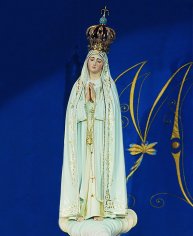| JUBILEE OF BISHOPS
PRESENTATION 
The profound communion which exists between the Bishop of Rome, the Successor of Peter, and the Bishops of the Particular Churches, the Successors of the Apostles; a wish to join in celebrating, in a spirit of conversion and renewal, the Great Jubilee which marks the two thousandth anniversary of the Nativity of our Lord Jesus Christ; and a desire to offer grateful homage to the Virgin of Nazareth who gave birth to the Saviour of the world: these are the inspiration behind this recitation of the Rosary with Holy Father. Not since the time of the Second Vatican Council (1962-1965) has there been so vast and representative a gathering of the worlds Bishops: the Universal Church is truly present in this meeting. Other characteristics of the meeting are: - an emphasis on the Churchs presence on the five continents: The leading of the five mysteries of the Rosary is entrusted successively to representatives - a Cardinal, a Bishop, a family - of the five Continents, in this order: Oceania, Asia, America, Africa, Europe; - a connection with the events of Fatima (1917): The same day on which this significant moment of the Jubilee of Bishops is being celebrated - 7 October, the Memorial of Our Lady of the Rosary, and the first Saturday of the month, both integral elements of the message of Fatima - as well as the recent Beatification of two of the visionaries - Francisco and Jacinta - led to this choice. The "Fatima presence" is brought out by certain characteristic signs, such as: the statue of Our Lady of Fatima in Saint Peters Square; the participation in the fifth mystery of Sister Lucia and the community of the Carmelite Monastery of Coimbra; the singing of songs associated with the Shrine of Fatima; the floral tribute to Our Lady to be presented by three Portuguese shepherd children. STRUCTURE The celebration has four parts: I. Introduction This includes: - the opening song "O Sanctissima", addressed to the Blessed Virgin, in which there blend the voices and hearts of all those taking part in the Jubilee of Bishops; - an introduction, which explains the meaning of the gathering to the faithful present; - the procession with the statue of Our Lady of Fatima, from the inside of the Vatican Basilica to its place on the esplanade of Saint Peters Square. The procession will be accompanied by the singing of the Litaniæ de Sancta Maria Regina; - the incensing of the statue by the Holy Father, followed by the prayer Deus, qui Filii tui Genetricem, taken from the Feast of the Queenship of Mary (22 August); - the Holy Fathers greeting and introduction, and the prayer Grant, Lord, set the meeting of the Bishops within the context of the celebration of the Jubilee Year.
II. Meditation on the mysteries of the Rosary The meditation on the five glorious mysteries of the Rosary takes place in eight parts: - the announcement of the mystery, followed by a brief explanation of its meaning; - the proclamation of the Word of God: a Bishop proclaims a passage of the New Testament which, whether in a literal or an accommodated sense, refers to the saving event which is the subject of the meditation; - the proclamation of the Word of the Church: a Cardinal proclaims a passage of the Apostolic Exhortation or Instrumentum Laboris of the corresponding Continental Assembly of Bishops held in preparation for the celebration of the Great Jubilee of the Year 2000; - the singing of a verse of the popular hymn of the Shrine of Fatima, in the course of which one of the five candles in front of the statue of the Blessed Virgin is lighted; - the Lords Prayer: a Cardinal (in the following order: Australian, Asian, American, African, European) recites the first part of the Our Father; the assembly responds by reciting the second part; - Ten "Hail Marys": a family member recites ten times the salutation of the Angel and of Elizabeth, the Hail, Mary, which is the characteristic element of the Rosary; the assembly responds with the ecclesial prayer Holy Mary; - praise to the Trinity: at the end of each decade the choir and the assembly glorify the Triune God by singing the traditional formula Gloria Patri; - a prayer to the Blessed Virgin: the Holy Father concludes the meditation of the mystery with a prayer addressed to the Mother of the Lord, which evokes the saving event just meditated upon.
III. Address of the Holy Father - After the recitation of the Rosary, the Holy Father addresses the Bishops assembled for the Jubilee and the other members of the faithful in attendance.
IV. Conclusion The conclusion has three sections: - the floral tribute to Our Lady of Fatima, presented by three Portuguese shepherd children while the choir and the assembly sing the Salve Regina; - the Apostolic Blessing imparted by the Holy Father; - the procession with the statue through Saint Peters Square to the "Mater Ecclesiæ" Monastery, accompanied by the singing of a few verses of the hymn Salve, Mater Misericordiæ. Among those taking part in the procession are students from the Saint Pius X Preseminary and women Religious living in Vatican City. |



